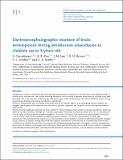| dc.contributor.author | Cornelissen, L. | |
| dc.contributor.author | Kim, S.E. | |
| dc.contributor.author | Lee, J.M. | |
| dc.contributor.author | Brown, Emery Neal | |
| dc.contributor.author | Purdon, P.L. | |
| dc.contributor.author | Berde, C.B. | |
| dc.date.accessioned | 2020-08-17T16:20:22Z | |
| dc.date.available | 2020-08-17T16:20:22Z | |
| dc.date.issued | 2018-04 | |
| dc.date.submitted | 2018-01 | |
| dc.identifier.issn | 0007-0912 | |
| dc.identifier.uri | https://hdl.handle.net/1721.1/126623 | |
| dc.description.abstract | Background: General anaesthetics generate spatially defined brain oscillations in the EEG that relate fundamentally to neural-circuit architecture. Few studies detailing the neural-circuit activity of general anaesthesia in children have been described. The study aim was to identify age-related changes in EEG characteristics that mirror different stages of early human brain development during sevoflurane anaesthesia. Methods: Multichannel EEG recordings were performed in 91 children aged 0–3 yr undergoing elective surgery. We mapped spatial power and coherence over the frontal, parietal, temporal, and occipital cortices during maintenance anaesthesia. Results: During sevoflurane exposure: (i) slow–delta (0.1–4 Hz) oscillations were present in all ages, (ii) theta (4–8 Hz) and alpha (8–12 Hz) oscillations emerge by ∼4 months, (iii) alpha oscillations increased in power from 4 to 10 months, (iv) frontal alpha-oscillation predominance emerged at ∼6 months, (v) frontal slow oscillations were coherent from birth until 6 months, and (vi) frontal alpha oscillations became coherent ∼10 months and persisted in older ages. Conclusions: Key developmental milestones in the maturation of the thalamo-cortical circuitry likely generate changes in EEG patterns in infants undergoing sevoflurane general anaesthesia. Characterisation of anaesthesia-induced EEG oscillations in children demonstrates the importance of developing age-dependent strategies to monitor properly the brain states of children receiving general anaesthesia. These data have the potential to guide future studies investigating neurodevelopmental pathologies involving altered excitatory–inhibitory balance, such as epilepsy or Rett syndrome. | en_US |
| dc.description.sponsorship | National Institutes of Health (Grants R01-GM104948 and DP1-OD003646 and DP2- OD006454) | en_US |
| dc.language.iso | en | |
| dc.publisher | Elsevier BV | en_US |
| dc.relation.isversionof | http://dx.doi.org/10.1016/j.bja.2018.01.037 | en_US |
| dc.rights | Creative Commons Attribution-NonCommercial-NoDerivs License | en_US |
| dc.rights.uri | http://creativecommons.org/licenses/by-nc-nd/4.0/ | en_US |
| dc.source | Elsevier | en_US |
| dc.title | Electroencephalographic markers of brain development during sevoflurane anaesthesia in children up to 3 years old | en_US |
| dc.type | Article | en_US |
| dc.identifier.citation | Cornelissen, L. et al. "Electroencephalographic markers of brain development during sevoflurane anaesthesia in children up to 3 years old." Neuroscience and Neuroanaesthesia 120, 6 (June 2018): 1274-1286. © 2018 The Author(s) | en_US |
| dc.contributor.department | Massachusetts Institute of Technology. Department of Brain and Cognitive Sciences | en_US |
| dc.relation.journal | Neuroscience and Neuroanaesthesia | en_US |
| dc.eprint.version | Final published version | en_US |
| dc.type.uri | http://purl.org/eprint/type/JournalArticle | en_US |
| eprint.status | http://purl.org/eprint/status/PeerReviewed | en_US |
| dc.date.updated | 2019-09-30T15:30:24Z | |
| dspace.date.submission | 2019-09-30T15:30:30Z | |
| mit.journal.volume | 120 | en_US |
| mit.journal.issue | 6 | en_US |
| mit.metadata.status | Complete | |
